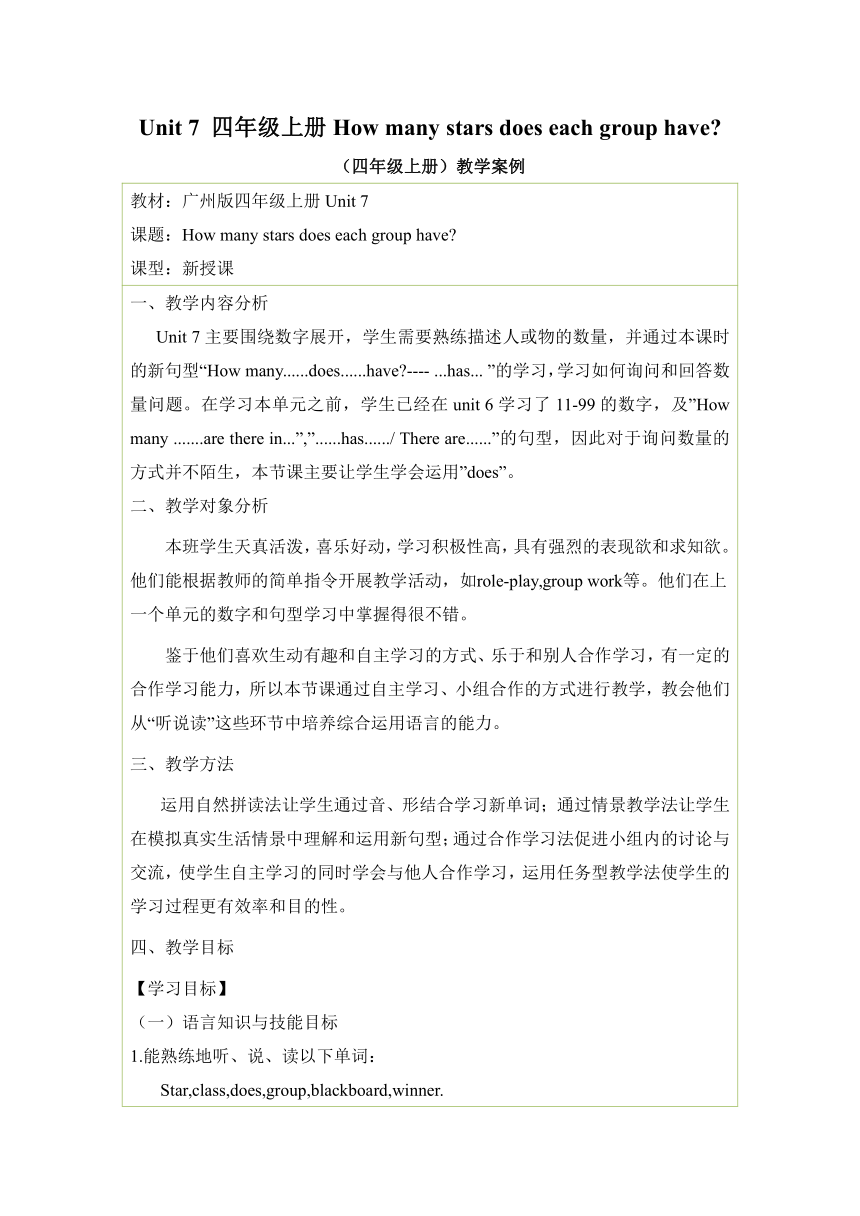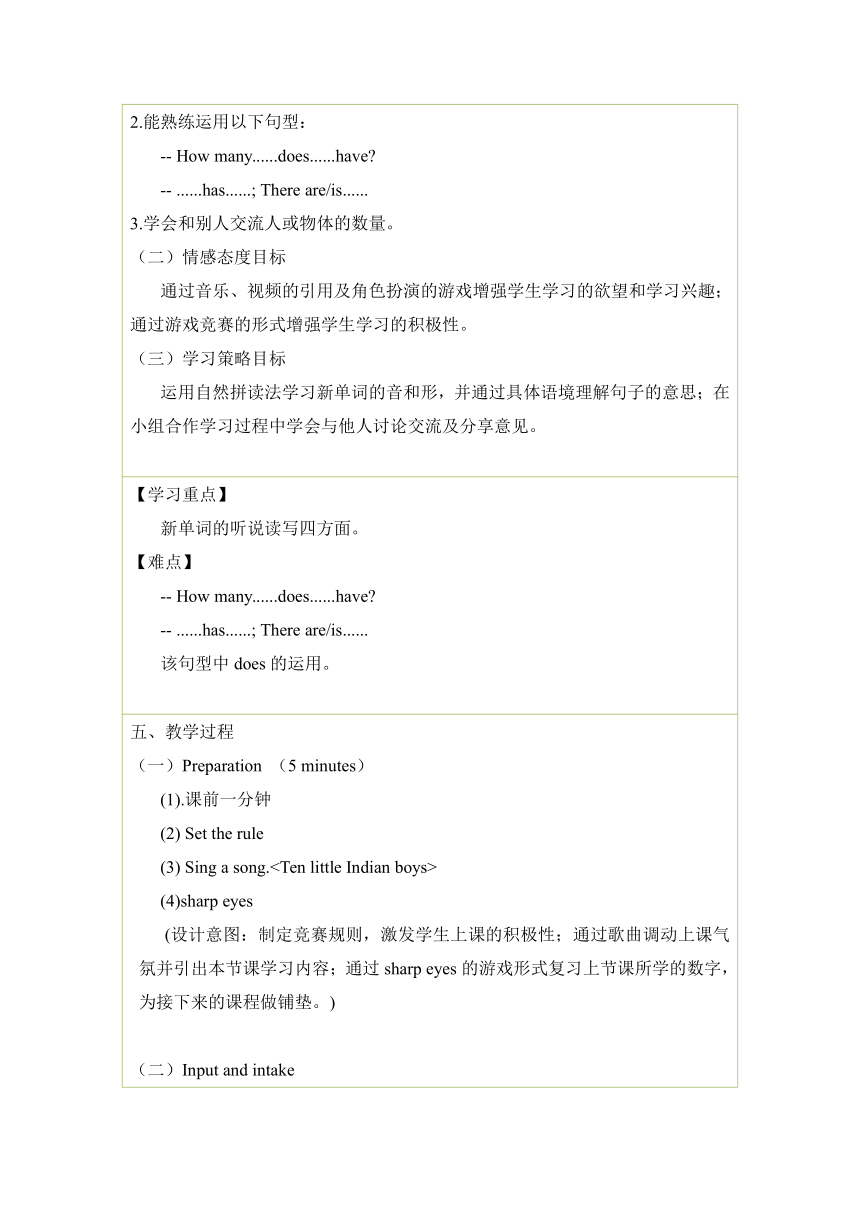Module 4 My class Unit 7 How many stars does each group have 表格式教案+导学案
文档属性
| 名称 | Module 4 My class Unit 7 How many stars does each group have 表格式教案+导学案 |

|
|
| 格式 | docx | ||
| 文件大小 | 138.2KB | ||
| 资源类型 | 教案 | ||
| 版本资源 | 教科版(广州) | ||
| 科目 | 英语 | ||
| 更新时间 | 2023-08-05 20:00:46 | ||
图片预览



文档简介
Unit 7 四年级上册How many stars does each group have
(四年级上册)教学案例
教材:广州版四年级上册Unit 7 课题:How many stars does each group have 课型:新授课
一、教学内容分析 Unit 7主要围绕数字展开,学生需要熟练描述人或物的数量,并通过本课时的新句型“How many......does......have ---- ...has... ”的学习,学习如何询问和回答数量问题。在学习本单元之前,学生已经在unit 6学习了11-99的数字,及”How many .......are there in...”,”......has....../ There are......”的句型,因此对于询问数量的方式并不陌生,本节课主要让学生学会运用”does”。 二、教学对象分析 本班学生天真活泼,喜乐好动,学习积极性高,具有强烈的表现欲和求知欲。他们能根据教师的简单指令开展教学活动,如role-play,group work等。他们在上一个单元的数字和句型学习中掌握得很不错。 鉴于他们喜欢生动有趣和自主学习的方式、乐于和别人合作学习,有一定的合作学习能力,所以本节课通过自主学习、小组合作的方式进行教学,教会他们从“听说读”这些环节中培养综合运用语言的能力。 三、教学方法 运用自然拼读法让学生通过音、形结合学习新单词;通过情景教学法让学生在模拟真实生活情景中理解和运用新句型;通过合作学习法促进小组内的讨论与交流,使学生自主学习的同时学会与他人合作学习,运用任务型教学法使学生的学习过程更有效率和目的性。 四、教学目标 【学习目标】 语言知识与技能目标 1.能熟练地听、说、读以下单词: Star,class,does,group,blackboard,winner. 2.能熟练运用以下句型: -- How many......does......have -- ......has......; There are/is...... 3.学会和别人交流人或物体的数量。 情感态度目标 通过音乐、视频的引用及角色扮演的游戏增强学生学习的欲望和学习兴趣;通过游戏竞赛的形式增强学生学习的积极性。 学习策略目标 运用自然拼读法学习新单词的音和形,并通过具体语境理解句子的意思;在小组合作学习过程中学会与他人讨论交流及分享意见。
【学习重点】 新单词的听说读写四方面。 【难点】 -- How many......does......have -- ......has......; There are/is...... 该句型中does的运用。
五、教学过程 (一)Preparation (5 minutes) (1).课前一分钟 (2) Set the rule (3) Sing a song. (4)sharp eyes (设计意图:制定竞赛规则,激发学生上课的积极性;通过歌曲调动上课气氛并引出本节课学习内容;通过sharp eyes的游戏形式复习上节课所学的数字,为接下来的课程做铺垫。) (二)Input and intake 1、创设情景,呈现新内容 通过引入人物Jolin上周末来到我们学校参观并提出与学校有关的问题来引出新单词和新句型的学习。 T: My friend Jolin came to our school last week, and she likes our school very much. She asked some questions about our school. Can you answer her (设计意图:通过创设有趣的情景,吸引学生的眼球,提高学生的英语学习兴趣。) 2、创设情景使学生操练本节课的新句型。 1)介绍Jolin的学校,引导学生使用新句型问关于Jolin学校的问题,接着让学生观看视频找出答案。 (设计意图:通过创设情景,使学生对Jolin的学校产生好奇心并乐意开口询问其学校的相关情况。同时能够让学生带着问题去看视频,顺便练习信息提取能力。 Play a game . (设计意图:通过角色扮演的趣味形式让学生重复操练本节课新句型。) 学习课文对话 (1) Set the scene, and then listen to the tape and fill in the blank. (2) Students read after the tape, and then read together. (设计意图:让学生带着问题去听课文对话,更有针对性;跟读对话利于学生模仿语音语调。) (三)、Output (1) Read the passage and fill in the blank. (2) Discuss with group members and then check the answers. (设计意图:由听说向读写转换,让学生带着问题读难度更大一点的文章,锻炼学生提取信息的能力。) (四)Homework 1、copy the new words in Activity book. 2、read after the tape 3、talk to your friends about Jolin’s school.
Unit 7 四年级上册How many stars does each group have
(四年级上册)学生导学案
教材:广州版四年级上册Unit 7 课题:How many stars does each group have (研学案)
班别: 姓名:
一、 研学目标 1、复习巩固数字,拼读和运用本课的新单词和新句型【Task1】 2、能理解本课内容。【Task2】 3、能背诵课文。【Task3】 4、能向别人询问及回答某样东西的数量。【Task4】 二、研学路线图 三、研学过程
一、激趣导学 Step1、Greeting. Step2、Sing a song. Step3. Sharp eyes. 小组研学 【Task1】:I can read and answer. (学新单词并小组讨论问题答案) 1.How many classes do you have 2. How many dining hall do you have 3.How many blackboards does one classroom have 4.How many groups does your class have 【Task2】:I can ask and find out the answers in the video. Students ask some questions about Jolin’s school with the sentence”How many...does...have ”, and then watch the video to find out the answers. 【Task3】:Role-play.(两人一组,操练句型) 根据表格及对话提示进行句型操练。 computer room2library1class30teachers' room6
Reporter: How many...... does Jolin's school have Student: Jolin's school has...... 【Task4】:Learn the dialogue on P38-39 Step 1: Students listen to the tape and write down the number of each group Group 1Group 2Group 3Stars
Step 2: Students read the dialogue in groups and then the whole class read together. 三、导练活学 【Task5】: P41. 4. Read, ask and answer. Read the passage and find out the answers of the questions. Before reading the text, teachers help students to find out the key words of each question. QuestionsAnswersHow many students are there in the school 45How many teachers are there in the school How many desks and chairs are there in the classroom Where’s the teachers’ room Where do the teachers sleep Where is the computer
【Task6】:I can conclude.(能根据文章和书上的表格总结课文主要内容。) Li Yangyang’s school Li Yangyang's school is very ________. There are 45 pupils and_______ teachers in her school. There is one big classroom in the school. The teachers' room is __________ the classroom. There is a table, two chairs and two ____________ in it. Teachers sleep in the _______________. Li Yangyang loves her school very much.
四、评价激励 熟练掌握数字、能拼读和运用本课的新单词能理解本课内容能背诵课文能向别人询问和回答某样东西的数量A( ) B( ) C( )A( ) B( ) C( )A( ) B( ) C( )A( ) B( ) C( )A代表“很好”,B代表“一般”,C代表“不满意”,根据自己在本课中的表现,在对应的栏内打“√”再小组内交流 。
(四年级上册)教学案例
教材:广州版四年级上册Unit 7 课题:How many stars does each group have 课型:新授课
一、教学内容分析 Unit 7主要围绕数字展开,学生需要熟练描述人或物的数量,并通过本课时的新句型“How many......does......have ---- ...has... ”的学习,学习如何询问和回答数量问题。在学习本单元之前,学生已经在unit 6学习了11-99的数字,及”How many .......are there in...”,”......has....../ There are......”的句型,因此对于询问数量的方式并不陌生,本节课主要让学生学会运用”does”。 二、教学对象分析 本班学生天真活泼,喜乐好动,学习积极性高,具有强烈的表现欲和求知欲。他们能根据教师的简单指令开展教学活动,如role-play,group work等。他们在上一个单元的数字和句型学习中掌握得很不错。 鉴于他们喜欢生动有趣和自主学习的方式、乐于和别人合作学习,有一定的合作学习能力,所以本节课通过自主学习、小组合作的方式进行教学,教会他们从“听说读”这些环节中培养综合运用语言的能力。 三、教学方法 运用自然拼读法让学生通过音、形结合学习新单词;通过情景教学法让学生在模拟真实生活情景中理解和运用新句型;通过合作学习法促进小组内的讨论与交流,使学生自主学习的同时学会与他人合作学习,运用任务型教学法使学生的学习过程更有效率和目的性。 四、教学目标 【学习目标】 语言知识与技能目标 1.能熟练地听、说、读以下单词: Star,class,does,group,blackboard,winner. 2.能熟练运用以下句型: -- How many......does......have -- ......has......; There are/is...... 3.学会和别人交流人或物体的数量。 情感态度目标 通过音乐、视频的引用及角色扮演的游戏增强学生学习的欲望和学习兴趣;通过游戏竞赛的形式增强学生学习的积极性。 学习策略目标 运用自然拼读法学习新单词的音和形,并通过具体语境理解句子的意思;在小组合作学习过程中学会与他人讨论交流及分享意见。
【学习重点】 新单词的听说读写四方面。 【难点】 -- How many......does......have -- ......has......; There are/is...... 该句型中does的运用。
五、教学过程 (一)Preparation (5 minutes) (1).课前一分钟 (2) Set the rule (3) Sing a song.
Unit 7 四年级上册How many stars does each group have
(四年级上册)学生导学案
教材:广州版四年级上册Unit 7 课题:How many stars does each group have (研学案)
班别: 姓名:
一、 研学目标 1、复习巩固数字,拼读和运用本课的新单词和新句型【Task1】 2、能理解本课内容。【Task2】 3、能背诵课文。【Task3】 4、能向别人询问及回答某样东西的数量。【Task4】 二、研学路线图 三、研学过程
一、激趣导学 Step1、Greeting. Step2、Sing a song
Reporter: How many...... does Jolin's school have Student: Jolin's school has...... 【Task4】:Learn the dialogue on P38-39 Step 1: Students listen to the tape and write down the number of each group Group 1Group 2Group 3Stars
Step 2: Students read the dialogue in groups and then the whole class read together. 三、导练活学 【Task5】: P41. 4. Read, ask and answer. Read the passage and find out the answers of the questions. Before reading the text, teachers help students to find out the key words of each question. QuestionsAnswersHow many students are there in the school 45How many teachers are there in the school How many desks and chairs are there in the classroom Where’s the teachers’ room Where do the teachers sleep Where is the computer
【Task6】:I can conclude.(能根据文章和书上的表格总结课文主要内容。) Li Yangyang’s school Li Yangyang's school is very ________. There are 45 pupils and_______ teachers in her school. There is one big classroom in the school. The teachers' room is __________ the classroom. There is a table, two chairs and two ____________ in it. Teachers sleep in the _______________. Li Yangyang loves her school very much.
四、评价激励 熟练掌握数字、能拼读和运用本课的新单词能理解本课内容能背诵课文能向别人询问和回答某样东西的数量A( ) B( ) C( )A( ) B( ) C( )A( ) B( ) C( )A( ) B( ) C( )A代表“很好”,B代表“一般”,C代表“不满意”,根据自己在本课中的表现,在对应的栏内打“√”再小组内交流 。
同课章节目录
- Module 1 My bedroom
- Unit 1 What's in your room?
- Unit 2 They're near the window
- Module 2 My house
- Unit 3 Welcome to my house
- Unit 4 I live in a big house
- Module 3 My school
- Unit 5 Let me show you our new school
- Unit 6 How many classrooms are there in your schoo
- Module 4 My class
- Unit 7 How many stars does each group have?
- Unit 8 I like English best
- Module 5 Clothes
- Unit 9 Look at this T-shirt
- Unit 10 Can I help you?
- Module 6 Occupations
- Unit 11 I want to be a painter
- Unit 12 What's your father's job?
- Module 7 Let's look back
